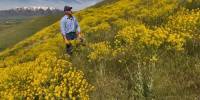© 2005 Katy Flanagan, All Rights Reserved.
This striking yellow plant is native to southeast Russia and is sometimes found as a garden ornamental in the western US. Dyer’s Woad is known as a source of blue dye (indigo) since the 13th century, and it was widely cultivated in England until 1930. Indigotine, the chemical producing the blue dye, is located in the leaves, and produced through fermentation. Dyer’s Woad is a non-palatable, aggressive weed with allelopathic properties (it produces chemicals which inhibit growth in other plants close by.) This species has a history of establishing across thousands of acres of western rangeland, and infestations are known from eight western states.
Since it is listed as a noxious weed in Idaho, Bannock County has started a unique “Bag a Woad” program. Dave Hallinan, Superintendent of Bannock County Weed Control tries to get as many land owners and citizens involved in identifying weeds and find out how serious a problem they are. One of the things Bannock County does to educate the public is to pay $10 for every 40 pounds of Dyer’s Woad that people bring to the landfill.
Last year 300 participants bagged over 95 tons. This year in just 6 days they pulled over 74 tons of Dyer’s Woad. They figured that at an estimate of 10,000 seeds per plant and 40 plants to make 100 pounds of Dyer’s Woad, that approximately 7 billion, 400 million seeds that never hit the ground because of the “Bag a Woad” program this year.
Lat: 42° 38' 0" N
Long: 113° 10' 0" W
Elevation: 4981 feet
Precision is: Unknown / Undeclared.



 Tap or click the zoom icon in the bottom right corner of the picture to switch between in-page and fullscreen view
Tap or click the zoom icon in the bottom right corner of the picture to switch between in-page and fullscreen view